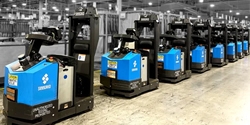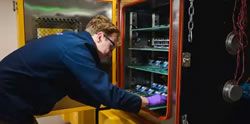Optimizing Wheel Drives for AGVs and AMRs: What OEMs Need to Know About Motion Control
The motor and actuator selection behind each wheel can make or break the success of the entire system. In this post, we'll explore the core challenges in mobile robot drive systems and how customized motion control solutions from DINGS' Motion USA can help you meet them.
Fully Autonomous Vehicles for Repetitive Hauling in Manufacturing
As our DriveMod vehicles are approaching an intersection, they send a request to the Cyngn Traffic Broker, a feature of Cyngn Insight that manages traffic coordination through an API.
Flexibility vs. Predictability in Mobile Automation: What Facilities Should Really Be Considering
There's a common misconception that AGVs are outdated while AMRs are cutting-edge. In
reality, both have evolved considerably in recent years, and modern mobile robots increasingly blur the lines between the two.
Improving AGV efficiencies with updated battery technologies
AGV-powered sectors like eCommerce and pharmaceuticals have set the pace for electric adoption, cutting emissions while streamlining operations. Yet, legacy batteries, whether lead-acid's sluggish charging or Li-ion's trade-offs in speed, cost, or size, limit progress.
Revolutionizing Warehouse Floors: How AGVs & AMRs are Driving Safety in Modern Manufacturing
With automated systems, the possibilities for implementation are endless, but depending on your business goals and needs, automated guided vehicles (AGVs) and autonomous mobile robots (AMRs) prove to be particularly impactful.
AGV and AMR Are Becoming More Complex
To enable the industry to keep pace with trends through quick and cost-efficient development, Markus Fenn and Prof. Dr. Stefan May developed Eduard, a teaching and prototyping platform that can be used to map current trends.
What Are The Differences Between Safe LiDAR and LiDAR?
One of the key elements to consider when selecting LiDAR technology is whether you need safe LiDAR or LiDAR. But what makes LiDAR safe? And when do you need a safety-rated device? Well, look no further, we've got the answers for you right here!
Delica Drives Efficiency with AGV Installation
Delica selected a Stöcklin AGV with BlueBotics' ANT navigation technology to automate their materials handling between production and logistics.
Kivnon AGVs Drive Efficiency for Forvia
Forvia, one of the world's leading automotive manufacturers, completes a successful AGV installation at its factory in Paraná, Brazil.
Forklift Safety: AGVs to the Rescue
As a relatively new addition to site operations, standards and data on AGV safety are still developing, but some AGV manufacturers are going above and beyond the minimum requirements to help ensure accident-free operations.
Investing in AGVs or AMRs? 6 Ways Engineered Mezzanine Flooring Maximizes Implementation Success
Having the wrong elevated flooring surface - such as concrete, which frequently has uneven surfaces, cracks, and spalling - can significantly hamper the function and productivity of AGVs and AMRs.
Warehouse Robots and Why Flooring is Important
One of the best ways today to improve business efficiency is through the use of warehouse robots. And while planning is underway to adopt warehouse robots, it's important to consider the most ideal flooring.
Why Do AGVs Need Reliable Motors?
Any automated system is only as good as its reliability. An automated guided vehicle (AGV) for example, needs to do the job it is programmed to do; without error, quickly and efficiently.
AGV or Conveyor - Which System Should You Choose?
Material logistics plays a crucial role in manufacturing processes and warehouses, but should a company choose an autonomous guided vehicle (AGV) or a conveyor system? Leaders in intralogistics solutions give their opinions on when and why each technology can make sense.
Most Accurate Lotus Car Ever, Thanks to Cutting Edge Metrology
The CMM installed in Hethel is set one meter into the floor on a special foundation. It means that a car for inspection carried on an automated guided vehicle (AGV) is able to access the area without the need for any lifting equipment.
Records 1 to 15 of 50
Featured Product

TM Robotics - Shibaura Machine THE SCARA range
The THE range from Shibaura Machine is an extensive line up of SCARA robots. Available in four arm lengths THE400 (400mm), THE600 (600mm) and the most recent THE800 (800mm) and THE1000 (1000mm), this range is suitable for assembly, handling, inspection and pick and place processes in varied industrial applications. The THE1000 boasts a 20kg payload capacity and an impressive 0.44 second cycle time, providing high speeds for processes with large components. In fact, the range has been recognised for as the price-to-performance leader compared to other SCARA models in its price range due to its impressive speed versus payload capacity.
Robotics and Automation - Featured Company

e-con Systems
Since 2003, e-con Systems® has been designing, developing & manufacturing custom and off-the-shelf OEM camera solutions. Backed by a large in-house team of experts, our cameras are currently embedded in 350+ customer products. So far, we have shipped over 2 million cameras to the USA, Europe, Japan, South Korea, & more. Our portfolio includes MIPI, GMSL, GigE, USB cameras, ToF & Stereo cameras & smart AI cameras. They come with industry-leading features, including low-light performance, HDR, global shutter, LED flicker mitigation, multi-camera synchronization, & IP69K-rated enclosure. e-con Systems® also offers TintE™ - an FPGA-based ISP with all necessary imaging pipeline components. It provides a full ISP pipeline as a turnkey solution, featuring optimized, customizable blocks like debayering, AWB, AE, gamma correction and more. Our powerful partner ecosystem, comprising sensor partners, ISP partners, carrier board partners, & more, enables us to offer end-to-end vision solutions.















